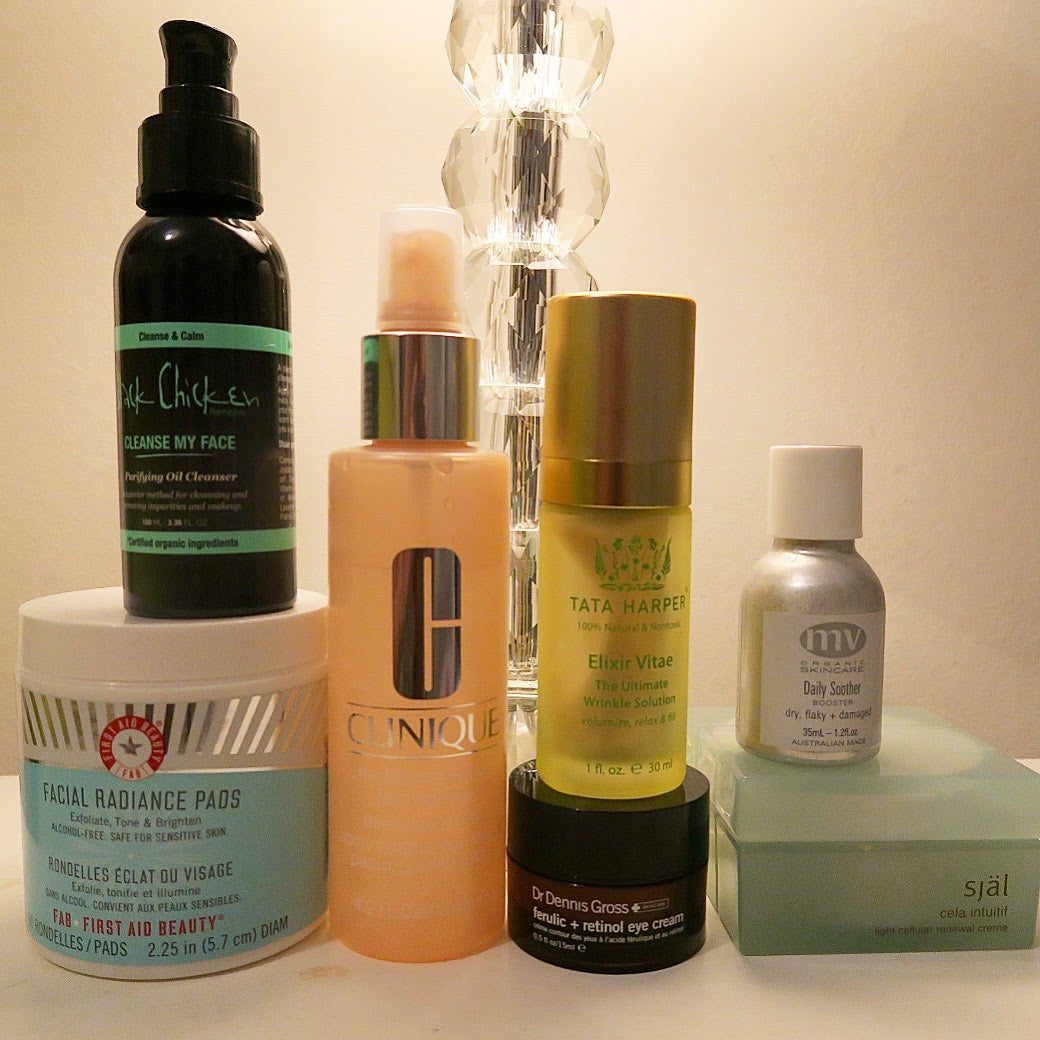Shop the full Skin Rocks Range
Before you read on - when I use the below terms I take them to mean:
Chemical-led: products that contain non-'natural' ingredients - anything.
Natural-led: products that would make the 'natural' consumer happy - may contain some non-natural ingredients, but the main bulk is natural.
Organic-led: would happily be endorsed by the green brigade.
And remember - nearly everything is technically a chemical, including water. It's how a product is marketed that makes the distinction.
One of my most-asked questions re ingredients is 'Is it natural?' and my answer is always 'Yes, if that's what you want.'
If you look closely at Instagram pictures of my routines that I've been sharing for a few months, you'll notice a pattern. I invariably tail end with natural-led products - and sandwich a lovely chemical serum in the middle.
See above for example, a Tata Harper sandwich with a Vichy and Kate Somerville filling.This is by no means set in stone.
Exhibit B above: Clinique to massacre my makeup. That's what they should have called this product by the way, 'Massacre'. Or 'Destroyer'. I digress. Clinique removes makeup, followed by a natural-led Oskia and finished with organic-led May Lindstrom Blue Cocoon. But before May Lindstrom, comes Sunday Riley Luna. That's not made of apples y'all. In the best way.
Exhibit C above: The Organic Pharmacy Carrot Butter Cleanser - proper organic here - no faffing about - Sjal to finish, which is natural-led but by no means 'green' and chemical-led Kate Somerville Mega C serum in the middle.
Why do I do it this way?
Predominantly because:
The best eye makeup removers invariably contain chemicals - case in point: Bioderma, Nars, Clarins and Charlotte Tilbury. That's removing surface junk so it's no problem for me personally...if you want to go natural you can go down the almond oil route, but I find that a tad heavy for my baggy eyelids and the residue can make them puffy.
Second Cleansers/skin cleanser are at some point going to used for facial massage, so I steer towards good oils/milk ingredients for that. Not always, but in general/most of the time.
Acid toners/Essences are by their very definition, chemical-led. Lovely.
Eye creams can be either, although I would probably go natural-led if your only concern was dryness/dehydration and chemical for everything else.
Serums for me are nearly always synthetic-led. Here's why: if you are out of your 20's and have lived any kind of life (I mean 'any', I'm not being facetious) you will have signs of ageing on your skin. And I'm sorry, but at a certain point, if you want to reverse those signs of ageing, you need to embrace the chemical. You, for 'green' reasons, may decide against that. That's 100% your prerogative obviously. But, for example, I have yet to meet a 'green, organic' product that can actually reverse sun damage, pigmentation and scarring as well as chemical-led retinoids. As much as people harp on about rosehip oil for scarring, it has nothing, nothing on retinoids available on prescription. It may be marketed as 'a natural alternative to retinol', but in reality that means that the proof has to be in the pudding, and they are just very, very different ingredients. See also: peptides.
Your serum is the product that will penetrate the most - it's the most 'active' product that you use. It's where you should embrace the 'chemical' and be a bit more spendy.
Again, as in the above picture, there are days where I reach for something organic in the serum department - usually when I want to get my glow on, really hydrate or if I am using a particularly silicone-heavy moisturiser. Which leads me to:
Moisturisers are probably the category where I mix it up the most. I love organic/natural-led hydrating, soothing moisturisers. I like how the majority (not all) of them are under makeup and I tend to use them on days where I am applying self-tan afterwards. The lack of silicone makes for better tanning. :)
If however, I feel my face needs some oomph and a little kick, I would probably use something hi-tech. For example: a Kate Somerville/Zelens serum under a Tata Harper moisturiser works a treat. Likewise, a Tata Harper serum under a Zelens/Kate Somerville moisturiser is also a good plan. Those three brands are probably the only ones where I would use both their serum and moisturiser together without an issue, but not very often. I like to mix it up a little.
The reason I invariably mix up the final two stages is silicone. A silicone serum, followed by a silicone moisturiser, followed by either SPF and/or a silicone primer makes for the higher possibility of 'rolling'. And I hate it when my products 'roll', it makes me feel dirty and like I have to do my entire routine again. Weird maybe, but that's just me. You have to do you.





























